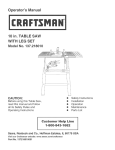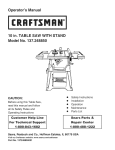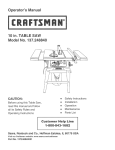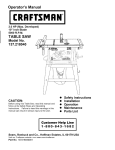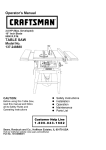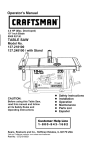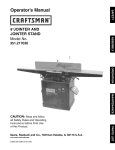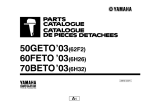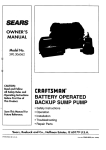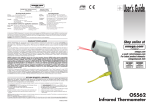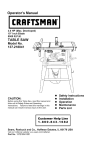Download Craftsman 137.218030 Operator`s manual
Transcript
Operator's Manual ® 10 in. TABLE SAW WiTH STAND Model No, 137.218030 CAUTION: Before using this Table Saw, read this manual and follow all its Safety Rules and Operating instructions Customer Help For Technical Visit our Craftsman Support website: o e Operation Maintenance • Parts List Repair Parts Center 1-800-488-1222 and Co., Hoffman Part No. 137218030001 Safety Instructions Installation Sears Line 1-800-843-1682 Sears, Roebuck e • Estates, www.sears.comlcraftsman IL 60179 USA & SECTION PAGE Warranty ........................................ 2 Product Specifications ....................... 2 Power Tool Safety ............................. 3 Table Saw Safety .................................. 4 Electrical Requirements and Safety ...... 5 Accessories and Attachments .............. 6 Tools Needed For Assembly ................ 6 Carton Contents .................................... 6 ONE=YEAR SECTION Know Your Table Saw ........................... Glossary of Terms ................................. Assembly and Adjustments ................. Operation ............................................. Maintenance .................................... Troubleshooting Guide ........................ Parts List ............................................. Push Stick Plan ................................... FULL WARRANTY ON CRAFTSMAN PAGE 8 9 10 17 22 23 24 28 TOOL if this Craftsman tool fails due to a defect in material or workmanship within one year from the date of purchase, CALL 1-800-4-MY-HOME® TO ARRANGE FOR FREE REPAIR (or replacement if repair proves impossible). if this tool is used for commercial or rental purposes, this warranty will apply for only ninety days from the date of purchase. This warranty applies only while this tool is in the United States. This warranty gives you specific legal rights, and you may also have other rights, which vary, from state to state. Sears, Roebuck and Co., Hoffman Estates, IL 60179 IAkWARNING I Some dust created by power sanding, sawing, grinding, drilling and other construction activities contains chemicals known to cause cancer, birth defects or other reproductive chemicals are: • • harm. Some examples of these Lead from lead-based paints Crystalline silica from bricks, cement and other masonry products • Arsenic and chromium from chemically treated lumber Your risk from these exposures varies, depending on how often you do this type of work. To reduce your exposure to these chemicals, work in a well ventilated area and work with approved safety equipment such as dust masks that are specially designed to filter out microscopic particles. MOTOR SAW Type .......................................................... Universal Amps ......................................................... Voltage ...................................................... Hz .............................................................. 15 120 60 RPM (no load) ........................................... 5000 [A WARNING] Rip Capacity With Extension ......... 24 in. Right & Left Blade Size .................................... 10 in. Blade Arbor Size .......................... 5/8 in. Maximum Maximum Maximum Maximum Cut Depth @ 90 ° .......... Cut Depth @ 45 ° .......... Diameter Dado ............. Dado Cut Width ............ 3 in. 2-1/2 in. 6 in. (Stackable only) 1/2 in. To avoid electrical hazards, fire hazards or damage to the tool, use proper circuit protection. This tool is wired at the factory for 110-120 Volt operation, it must be connected to a 110-120 Volt / 15 Ampere time delay fuse or circuit breaker. To avoid shock or fire, replace power cord immediately if it is worn, cut or damaged in any way. Before using your tool, it is critical that you read and understand these safety rules. Failure to follow these rules could result in serious injury to you or damage to the tool. GENERAL SAFETY iNSTRUCTiONS Read and understand all the instructions below before using the power tool. These safety instructions are not meant to cover every possible condition that could occur. As with any power tool, common sense, vigilance and due care must be used. READ and become familiar with this entire Operator's Manual. LEARN the tool's applications, limitations and possible hazards. 2. [A wAn.I.GJ Look for this symbol that identifies important safety precautions. It means BE ALERTt YOUR SAFETY IS iNVOLVED! 3. NEVER OPERATE THIS MACHINE WITHOUT THE SAFETY GUARD iN PLACE FOR ALL THROUGH= SAWING OPERATIONS. 4. DO NOT USE iN A DANGEROUS ENVIRONMENT such as damp or wet locations or in the rain. Keep work area well lighted. 5. DO NOT use power tools in the presence of flammable liquids or gases. 6. KEEP WORK AREA CLEAN. Cluttered areas and benches invite accidents. 7. KEEP CHILDREN AWAY. All visitors should be kept at a safe distance from the work area. 8. DO NOT FORCE THE TOOL. It will do the job better and safer if used at the rate for which it was designed. 9. USE THE RIGHT TOOL. Do not force the tool or attachment to do a job for which it is not designed. 10. WEAR PROPER APPAREL. DO NOT wear loose clothing, gloves, neckties, rings, bracelets or other jewelry that may get caught in moving parts. Nonslip footwear is recommended. Wear protective hair covering to contain long hair. 11. WEAR A FACE MASK OR DUST MASK. Sawing, cutting and sanding operations produce dust. 12. DISCONNECT TOOLS before servicing and when changing accessories, such as blades, cutters, etc. 13. REDUCE THE RISK OF UNINTENTIONAL STARTING. Make sure the switch is in the OFF position before plugging tool into the power supply. adjusting wrenches are removed from the tool before turning ON. 16. NEVER LEAVE TOOL RUNNING UNATTENDED. TURN THE POWER OFF. Do not leave the tool before the blade comes to a complete stop. 17. NEVER STAND ON TOOL. Serious injury could occur if the tool is tipped or if the cutting tool is unintentionally contacted. 18. DO NOT OVERREACH. balance at all times. Keep proper footing and 19. MAINTAIN TOOLS WITH CARE. Keep tools sharp and clean for most efficient and safest performance. Follow instructions for lubricating and changing accessories. 20. CHECK FOR DAMAGED OR LOOSE PARTS. Check for alignment of moving parts, binding of moving parts, loose mounting and any other conditions that may affect its safe operation. A guard or other part that is loose or damaged should be properly adjusted, repaired or replaced. 21. MAKE WORKSHOP CHILDPROOF with padlocks, master switches or by removing starter keys. 22. DO NOT operate the tool if you are under the influence of any drugs, alcohol or medication that could impair your ability to use the tool safely. 23. USE A DUST COLLECTION SYSTEM whenever possible. Dust generated from certain materials can be hazardous to your health and, in some cases, a fire hazard. Always operate the power tool in a well-ventilated area with adequate dust removal. 24. ALWAYS WEAR EYE PROTECTION. Any power tool can throw debris into your eyes that could cause permanent eye damage. ALWAYS wear safety goggles (not glasses) that comply with ANSI safety standard Z87.1. Everyday glasses have only impact resistant lenses. They ARE NOT safety glasses. NOTE: Glasses or goggles not in compliance with ANSI Z87.1 could cause serious injury when they break. 14. USE ONLY RECOMMENDED ACCESSORIES. Consult the Operator's Manual for recommended accessories. The use of improper accessories may cause injury to you or damage to the tool. 25. DiRECTiON OF FEED. Feed work into a blade or cutter against the direction of rotation of the blade or cutter only. 15. REMOVE ADJUSTING KEYS AND WRENCHES. Form the habit of checking to see that keys and 26. DO NOT loan your tool to a neighbor or friend without providing him/her with the Operator's Manual. Be sure he/she learns the tool's applications and possible hazards. ALWAYS USE SAW BLADE GUARD, splitter and anti-kickback pawls for every through-sawing operation. Through-sawing operations are those in which the blade cuts completely through the workpiece when ripping or crosscutting. Always be sure blade guard is tightened securely. 2. 3. 4. you) by keeping the blade sharp, the rip fence parallel to the saw blade and by keeping the splitter, anti-kickback pawls and guards in place, aligned ALWAYS HOLD WORK FIRMLY against the miter gauge or rip fence. and functioning. Do not release work before passing it completely beyond the saw blade. Do not rip work that is twisted, warped or does not have a straight ALWAYS USE a push stick, especially when ripping narrow stock. Refer to ripping instructions in this Operator's Manual where the push stick is covered in detail. A pattern for making your own push stick is included on page 28. edge to guide it along the fence. Do not attempt to reverse out of a cut with the blade running. NEVER PERFORM ANY OPERATION FREEHAND, which means using only your hands to support or guide the workpiece. Always use either the fence or the miter gauge to position and guide the work. [,_ DANGER J FREEHAND CUTTING IS THE MAJOR CAUSE OF KICKBACK AND FINGER/HAND AMPUTATIONS. NEVER USE THE MITER GAUGE AND FENCE SIMULTANEOUSLY. 5. 12. PROVIDE ADEQUATE SUPPORT to the rear and the sides of the saw table for long or wide workpieces. 13. AVOID KICKBACKS (work thrown back towards NEVER STAND or have any part of your body in line with the path of the saw blade. Keep your hands out of the saw blade path. 14. AVOID AWKWARD OPERATIONS and hand positions where a sudden slip could cause your hand to move into the saw blade. 15. NEVER USE SOLVENTS to clean plastic parts. Solvents could possibly dissolve or otherwise damage the material. Only a soft damp cloth should be used to clean plastic parts. 16. MOUNT your table saw on a bench or stand before performing any cutting operations. Refer to ASSEMBLY on page 10. 17. NEVER CUT METALS or materials that may make hazardous dust. 18. ALWAYS USE IN A WELL-VENTILATED 6. NEVER REACH behind or over the cutting tool for any reason. 7. AREA. Remove sawdust frequently. Clean out sawdust from the interior of the saw to prevent a potential fire hazard. REMOVE the rip fence when crosscutting. 19. NEVER LEAVE THE SAW RUNNING 8. DO NOT USE a molding head with this saw. UNATTENDED. Do not leave the saw until the blade comes to a complete stop. 9. FEED WORK INTO THE BLADE against the direction of rotation only. 20. FOR PROPER OPERATION follow the instructions in this Operator's Manual entitled OPERATION 10. NEVER use the rip fence as a cut-off gauge when (Page 17). crosscutting. NOTE: On machines with no stand or if stand is not 11. NEVER ATTEMPT TO FREE A STALLED SAW BLADE without first turning the saw OFF. Turn power switch OFF immediately to prevent motor damage. being used, a hole approximately 11 in. square must be cut under saw to allow sawdust to fall through. Failure to cut this hole will allow sawdust to build up in the motor area, resulting in a fire hazard and potential motor damage. GROUNDING iNSTRUCTiONS tN THE EVENT OF A MALFUNCTION OR BREAKDOWN, grounding provides a path of least resistance for electric currents and reduces the risk of electric shock. This tool is equipped with an electrical cord that has an equipment-grounding conductor and a grounding plug. The plug must be plugged into a matching receptacle that is properly installed and grounded in accordance with all local codes and ordinances. DO NOT MODIFY THE PLUG PROVIDED. If it will not fit the receptacle, have the proper receptacle installed by a qualified electrician. IMPROPER CONNECTION of the equipment grounding conductor can result in risk of electric shock. The conductor with the green insulation (with or without yellow stripes) is the equipment grounding conductor. tf repair or replacement of the electrical cord or plug is necessary, do not connect the equipment grounding conductor to a live terminal. CHECK with a qualified electrician or service person if you do not completely understand the grounding instructions, or if you are not certain the tool is properly grounded. or a #14 wire with a 15 A time-lag fuse. NOTE: When using an extension cord on a circuit with a #14 wire, the extension cord must not exceed 25 feet in length. Before connecting the motor to the power line, make sure the switch is in the off position and the electric current is rated the same as the current stamped on the motor nameplate. Running at a lower voltage will damage the motor. This tool is intended for use on a circuit that has a receptacle like the one illustrated in Fig. 1. Fig. 1 shows a three-pronged electrical plug and receptacle that has a grounding conductor. If a properly grounded receptacle is not available, an adapter (Fig. 2) can be used to temporarily connect this plug to a twocontact grounded receptacle. The adapter (Fig. 2) has a rigid lug extending from it that MUST be connected to a permanent earth ground, such as a properly grounded receptacle box. CAUTION In all cases, make certain the receptacle is properly grounded, if you are not sure, have a qualified electrician check the receptacle. CAUTION This tool is for indoor use only. Do not expose to rain or use in damp locations. Fig. 1 ged Plug USE only three-wire extension cords that have threepronged grounding plugs with three-pole receptacles that accept the tool's plug. Repair or replace damaged or worn cords immediately. GUiDELiNES FOR EXTENSION g Prong Properly Grounded Three-Pronged Receptacle CORDS USE THE PROPER EXTENSION CORD. Make sure your extension cord is in good condition. Use an extension cord heavy enough to carry the current your product will draw. An undersized cord will cause a drop in line voltage resulting in loss of power, overheating and burning out of the motor. The table on the right shows the correct size to use depending on cord length and nameplate ampere rating, tf in doubt, use the next heavier gauge. The smaller the gauge number, the heavier the cord. Make sure your extension cord is properly wired and in good condition. Always replace a damaged extension cord or have it repaired by a qualified technician before using it. Protect your extension cords from sharp objects, excessive heat and damp or wet areas. Use a separate electrical circuit for your tool. This circuit must not be less than #12 wire with a 20 A time-lag fuse Grounding Lug Fig. 2 Make sure this is connected to a known ground. Two-Pronged Receptacle Adapter CAUTION This tool must be grounded while in use to protect the operator from electric shock. ' O" • O'm ' (When using 120 volts only) Ampere Rating Total length of Cord MoreThan Not MoreThan 25ft. 50ft. 100ft. 150ft. 0 6 8 16 16 14 6 10 10 12 8 6 I6 16 14 14 12 12 RECOMMENDED [_ WARNING ACCESSORIES UNPACKING I Visit your Sears Hardware Department or see the Craftsman Power and Hand Tools Catalog to purchase recommended accessories for this power tool. AND CHECKING CONTENTS Separate all parts from packing materials. Check each part with the illustration on the next page and the "Table of Loose Parts" to make certain all items are accounted for, before discarding any packing material. [A WARNING I IA WARNING I To avoid the risk of personal injury: • Do not use adjustable (wobble) type dadoes or if any part is missing or damaged, do not attempt to assemble the table saw, plug in the power cord, • • carbide tipped dado blades. Only use stackable dadoes. Maximum dado width is 1/2". • Do not use a dado with a diameter • • Do not use molding head set with this saw. Do not modify this power tool or use accessories not recommended by Sears. larger than 6". or turn the switch ON until the missing or damaged part is obtained and is installed correctly. To avoid electric shock, use only identical replacement parts when servicing double insulated tools. Call 1=800=4-MY=HOME® for replacement TABLE ITEM A B C SUPPLIED Blade wrench NOT SUPPLIED Medium screwdriver #2 Phillips screwdriver Blade wrench [ II II II III II OF LOOSE parts. PARTS D E F DESCRIPTION Table saw assembly Blade guard and splitter ass'y Bolt, flat washer, toothed washer, oval washer, spring washer Rip fence, handle & nut Handwheel Dome nut QUANTITY 1 1 1 each G H t J Miter gauge Hex key Blade wrench Left table extension fence 1 2 2 1 K L M Right table extension fence Locking knob Blade 1 4 1 Short upper support Long upper support Short bottom support Long bottom support Leg Stand mounting hardware bag 2 2 1 2 2 I Straight edge 3 mm Hex Key STAND O P 4 mm Hex Key Adjustable wrench I 'i't'l'I"l'i'l 'i"l:_ Combination square Q R S T 2 2 4 1 NOTE: To make assembly easier, keep contents of box together. Apply a coat of automobile wax to the table. Wipe all parts thoroughly with a clean dry cloth. This will reduce friction when pushing the workpeice. To avoid injury, the styrofoam block should be removed between the motor and the table. UNPACKING YOUR TABLE SAW 1 A H G E L t J o I o K M [1 G i [1 i O [1 [1 P t Blade guard Miter gauge Side table extension Rip fence _ Table insert Table Left extension fence Right extension fence Extension fence lock knob Blade bevel lock knob Blade tilt pointer Blade tilting handwheel Blade tilt scale Blade elevation handwheel ON/OFF switch with safety key Overload reset switch - Rip fence storage hook Miter gauge storage Stand Front stand mounting holes Anti-kickback pawls Blade Splitter Splitter bracket Blade wrenches Rear mounting holes ANTFKICKBACK PAWLS- Prevents theworkpiece frombeingkickedupwardor backtowardthefrontof the tablesawbythespinningblade. OVERLOAD RESETSWITCH - Resetsthe thermocouple andprovidesa wayto restartthesaw motorif it overloads oroverheats. ARBOR- Theshaftonwhichthebladeordadois mounted. PUSHSTICK- Specialaccessory thatis usedtopush workpieces whenperforming rippingoperations. BEVELCUT- Ananglecutmadethroughthefaceof theworkpiece. RESIN- A stickysapthathashardened. BLADEBEVELSCALE- Measures theangletheblade is tiltedwhensetfora bevelcut. BLADEELEVATION HANDWHEEL - Raisesand lowerstheblade. BLADEGUARD- Clearplasticcoverthatpositions itselfoverthebladewhilecutting. COMPOUND CUT- Asimultaneous bevelandmiter cut. CROSSCUT - A cut made across the width of the workpiece. DADO - Special cutting blades that are used to cut grooves in a workpiece. FREEHAND - Performing a cut without using a rip fence, miter gauge, hold down or other proper device to prevent the workpiece from twisting during the cutting operation. GUM - A sticky sap from wood products. HEEL - Misalignment of the blade. REVOLUTIONS PERMINUTE(RPM)- Thenumberof turnscompleted bya spinningobjectinoneminute. RIPFENCE- A guideusedforripcuttingwhichallows theworkpiece tocutstraight. RiPPiNG- Cutting with the grain of the wood or along the length of the workpiece. SAW BLADE PATH - The area of the workpiece or table top directly in line with the travel of the blade or the part of the workpiece that will be cut. SET - The distance between two saw blade tips, bent outward in opposite directions to each other. The further apart the tips are, the greater the set. SPLITTER - Keeps the workpiece split apart after being cut to prevent binding on the blade and workpiece. TABLE INSERT - Metal insert that is removed from the table to install / remove blades, tt is also removed for dado cutting. When dado cutting, a dado insert plate must be used. THROUGH- SAWING - Making a cut completely through the length or width of a workpiece. WORKPIECE - Material to be cut. JAM NUT - Nut used to lock another nut in place on a threaded rod or bolt. Leading edge KERF - The amount of material removed by the blade cut. Saw blade path Kerf Surface MITER CUT - An angle cut made across the width of the workpiece. Trailing edge MITER GAUGE - A guide used for crosscutting operations that slides in the table top channels (grooves) located on either side of the blade, it helps make accurate straight or angle crosscuts. Workpiece ASSEMBLESTAND(FIG.A) 1. Unpackallpartsandgroupbytypeandsize(Fig.A). Referto partslistforquantities. 2. Attachonelonguppersupport(P)totopofleg(S) usingonesquareneckbolt(1)andnut(2). NOTE: • Aligndetentsinstandlegwithsupportbracketsto ensureproperfit. • Donottightenboltsuntilstandis properly aligned(seestep#8 beforetightening). 3. Attachotherendof longuppersupporttotopof anotherlegusingonesquareneckboltandnut. 4. Attachonelongbottomsupport(R)tocenterofeach legusingsquareneckboltsandnuts.Thiscompletes thefrontframesection. 5. Assemblerearframesectioninexactlythesame way. 6. Joinfrontandrearframeassemblies usingtwo shortuppersupports(O)andtwoshortbottom supports(Q),squareneckboltsandnuts. 7. Insertlargehexheadbolt(3)intorubberfoot(4)and insertintobottomof leg.Fastenwithwasher(5)and nut(6).Repeatforeachleg. 8. Attachthehook(7)totheleftofthestandwithbolt(8) andnut(9)forthe mitergaugestorage.Attachthe hook(12)totherightofthestandwithboltandnut forthe ripfencestorage. 9. Placestandonlevelsurfaceandadjustso alllegs arecontacting thefloorandareatsimilarangles tothefloor,anddetents(13)in standlegalignwith supportbrackets,thentightenallbolts. NOTE:Standshouldnotrockafterall boltsare tightened. ASSEMBLE TABLESAWTOSTAND(FIG.A, B) 1. Placeprotective corrugated cardboard oroldblanket onfloortoprotectthesawtablesurface. 2. Placethesawup-sidedownontheprotective material(Fig.B). 3. Positionthestandup-sidedownonthesawbase. NOTE:Makesurefrontofstandandfrontof saware facingthesamedirection. 4. Lineupthefourholesinsawbaseandstand. 5. Fastensawtostandusingfourbolts(10),washers (11) andnuts(8). NOTE:Placewasheroneach bolt before inserting into saw base and through the support. Nut must be flush against the bracket (see Fig. A). 6. Tighten all four nuts. 7. Carefully set the saw in its upright position on a clean level surface. NOTE: DO NOT OVER TIGHTEN NUTS HOLDING SAW TO STAND. THIS MAY DAMAGE THE SAW BASE. IA WARNING I IF THE STAND WILL NOT BE USED, DO NOT OPERATE THE TABLE SAW ON THE FLOOR. THIS IS A VERY DANGEROUS POSITION. Fig, B Fig, A Q S 10 STORAGE (FIG. B=f, FiG. B-2) Rip fence and miter gauge 1. Storage bracket for the rip fence (1) is located on the right side of the stand. 2. Storage bracket for the miter gauge (2) is located on the left side of the stand. Fig. C SQUARE CUTOUT _-- 2 1 Fig. B-f I,AWARNING ! Failure to provide the sawdust fall=through hole for use of the saw when mounted to a work surface and not the stand will cause sawdust to build up in the motor area, which may result in fire or cause motor damage. Fig. B-2 KEEPING THE AREA CLEAN 1. Sawdust and wood chips that fall from under the saw will accumulate on the floor. 2. Make it a practice to pick up and discard this dust when you have completed cutting. -2 BLADE RAISING HANDWHEEL (FIG. D, E) 1. Attach the up-down handwheel (1) to the elevation rod (2) at the front of the saw. Make sure the slots (3) in the hub of the handwheel (1) engage with the pins (4). 2. Attach and tighten the dome nut (5 - Fig. E). MOUNTING SAW ONTO WORK SURFACE (FIG. C) 1. tf the leg set will not be used, the saw must be properly secured to a sturdy workbench using the four mounting holes at the base of the saw. 2. The surface of the table where the saw is to be Fig. D mounted must have a hole large enough to facilitate sawdust fall-through and removal. 3. Square the saw on the mounting surface and mark the location of the four 3/8 in. mounting holes (1). 4. Drill 3/8 in. hole into the mounting surface. 5. Mark an 11 in. square (2) centered between the four 1 mounting holes (1). 6. Cut out and remove the square. 7. This opening will allow sawdust to fall through the saw base. BLADE TILTING HANDWHEEL (FIG. E) 1. Attach the bevel 0 ° - 45 ° handwheel (6) to the blade 8. Place the saw on the work surface and align the mounting holes of the saw with those drilled through the surface. 9. Fasten the saw to the work surface. 2. Attach and tighten the handwheel dome nut (5). tilting rod on the right side of the saw in the same manner as above. Fig. E [A WARNING I Do not operate this machine on the floor. This is very dangerous and may cause serious injury. 11 RiPFENCE(FIG.F) 1. Threadthefencehandle(1)intothecamhole(2) untiltight.Securebytightening thenut(5)against thefencehead. 2. Liftupwardonthe ripfencehandle(1)sothe rear clamp(3)isfullyextended. 3. Placetheripfenceonthesawtableengagingthe rearclamptotherearofthetablefirst,thenlowerthe frontendontothetable(4). 4. Pushdownonthefencehandle(1)to lock. 2. Raise the blade arbor (4) (Fig. H) to the maximum height by turning the blade raising handwheel counterclockwise. 3. Place the open-end wrench jaws (8) on the flats of the saw arbor to keep the arbor from turning (Fig. t) and place the box-end wrench (9) on the arbor nut (5), and turn counterclockwise. 4. Remove the arbor nut (5) and outer flange (6) (Fig. H). 5. Install the saw blade onto the arbor with the blade teeth pointing toward the front of the saw. 6. Install the flange (6) against the blade and thread the arbor nut (5) as far as possible by hand. Ensure that the blade is flush against the inner side of the blade flange. Fig.F IA WARNING ! To avoid possible injury and damage to the workpiece be sure to install the blade with the teeth pointing toward the front of table in the direction of the rotation arrow on the blade guard. iI 4 Fig, H 1 INSTALLING AND CHANGING THE BLADE (FIG. G, H, I) NOTE: Blade teeth must face forward towards front of saw. [,_k WARNING • • J To avoid injury from an accidental start, make sure the switch is in the OFF position and the plug is not connected to the power source outlet. To avoid serious injury, the rear of the table insert must be level with the table. Adjust the rear screw (3) until the rear of the insert is level with the table. To raise the insert, turn the screw counterclockwise, to lower the insert, turn the screw clockwise. NOTE: A rubber adjusting spacer (4) is provided under rear of insert for this purpose. 7. To tighten the arbor nut (5) place the open-end wrench jaws (8) on the fiats of the saw arbor to keep the arbor from turning. (Fig. 1) 8. Place the box-end wrench (9) on the arbor nut (5), and turn clockwise (to the rear of the saw table). 9. Replace the blade insert in the table recess, insert the screws through the front and rear holes and tighten remembering the rubber adjusting spacer (4-Fig. G) under the rear of the insert. Fig, I 1. Remove the table insert (1) by removing the two screws (2, 3). Be careful not to lose the rubber spacer (4) that is on the back screw (3) beneath the table insert. (Fig. G) Fig, G J,_ WARNING To avoid injury from a thrown workpiece, blade parts, or blade contact, never operate saw without the proper insert in place, Use the original installed insert for all through=sawing operations except dado cuts. A special dado insert plate must be installed when using a dado blade. 2 12 BLADEGUARDASSEMBLY (FIG. 1. 2. 3. J, K, L) Set the blade to maximum height and the tilt to zero degrees on the bevel scale with the hand wheels. Lock the blade bevel lock knob. kickback pawls and guards in place, aligned and functioning. Do not release work before passing it completely beyond the saw blade. Do not rip work that is twisted, warped or does not have a straight edge to guide it along the fence. Do not attempt to reverse out of a cut with the blade running. Improper splitter alignment can cause "kickback" and serious injury. Place the spring washer (2), flat washer (3), external tooth lock washer (4) onto the blade guard mounting bolt (1)(Fig. J). Insert bolt and washer assembly through splitter bracket (5). 5 Fig. J Fig. L 4 Anti-Kickback Pawl 9 I1 2 Blade guard and splitter ass'y 3 1 11 4. 5. INSTALLING Place the oval washer (6) on the pivot rod (7) (Fig. K). Install the blade guard and splitter and bracket assembly (8) into the rear of the saw table. Thread the bolt (1) into the internally threaded pivot rod until snug. (FIG. M, M-l) NOTE: A. For right ripping a 10 in.- 14 in. wide workpiece, the right extension fence has to be installed in the IN-RIP position (Fig. M). For left ripping a 11 in. - 16 in. wide workpiece, the left extension fence has to also be installed in the IN-RIP position. Raise the fence to a position that just clears the table surface and secure in place using lock knobs (1) for IN-RIP position. B. For right ripping a 14 in. - 24 in. wide workpiece, the right extension fence has to be installed in the OUTRiP position (Fig. M-l). For left ripping a 16 in. - 24 in. wide workpiece, the left extension fence has also to be installed in the OUT-RIP position. To install fence: Fig. K 7 6. 7. 8. THE TABLE EXTENSION FENCE 6 Lift blade guard arm (9) up and using a straight edge, align the blade guard and splitter (10) with the saw blade (11 ) (Fig. L). Shift the splitter bracket assembly to right or left until parallel alignment to the blade is achieved. When the splitter is properly aligned with the saw blade, tighten the bolt securely. NOTE: The splitter bracket must always be correctly aligned so the cut workpiece will pass on either side without binding or twisting. 1. Install the lock knobs (1) on the aluminum extension table. 2. Place the table extension fence (2) on the aluminum extension table. 3. Raise the fence to the desired location and height and tighten the lock knobs (1). WARNING I See Fig. K-1 fiat washer (11) must be under knob (12). NOTE: Be sure to tighten knob very tight and periodically check tightness. Fig. M Fig. K=I "_ Fig. M-f [A WARNING I • AVOID KICKBACKS (FIG. L) (Work thrown back towards you) by keeping the blade sharp, the rip fence parallel to the saw blade and by keeping the splitter, anti13 ___ 2_1 ADJUSTMENT iNSTRUCTiONS RiP FENCE ADJUSTMENT (FIG. P) 1. The fence (1) is moved by lifting up on the locking handle (2) and sliding the fence to the desired location. Pushing down on the handle locks the fence in position. 2. Position the fence on the table and along one edge of the miter gauge grooves. 3. Lock the fence handle. The fence should be parallel with the miter gauge groove. 4. tf adjustment is needed to make the fence parallel to the groove, do the following: • Loosen the two bolts (3) and lift up on the handle (2). • Hold the fence bracket (4) firmly against the front of the saw table. Move the far end of the fence until it is parallel with the edge of the miter gauge groove. • Push the handle to lock and then tighten both bolts. 5. tf fence is loose when the handle is in the locked (downward) position, do the following: • Lift the handle (2) upward and turn the adjusting [A WARNING I To avoid injury from an accidental start, make sure the switch is in the OFF position and the plug is not connected to the power source before making any adjustments. USING THE TABLE EXTENSION FENCE (FIG. N) NOTE: The table extension may be used as side support when cutting large workpieces. To adjust the table extension position 1. Loosen the two lock knobs (4) on the two extension tube brackets. 2. Slide the extension tubes in or out to the desired distance and tighten the two lock knobs (4). 3. To adjust extension fence (6), loosen lock knobs (5) and adjust the extension fence (6) to desired position. Tighten lock knobs (5). screw (5) clockwise until the bottom of the rear clamp is 1/16 in. away from the rear of the table. 6 Fig. N --5 NOTE: Over-tightening the adjusting screw will cause the fence to come out of alignment. IA WARNING ! 5 Failure to properly align fence can cause "kickback" and serious injury. NOTE: Always align rip fence and blade so that they are parallel to the miter gauge groove of the table. MITER GAUGE ADJUSTMENT (FIG. O) 1. To check miter gauge squareness, loosen lock handle (1) to allow miter body (3) to rotate freely. Position the miter head so the pointer (2) points to 90 ° on the scale. Tighten lock handle to hold miter head in position. Use a square to verify the 90 ° angle between the miter body and the slide bar. 2. If adjustment is needed, square the miter head to 90 °, loosen the pointer locking screw and adjust pointer to 90 ° on the protractor scale then tighten the locking screw. 3. To change angles on miter gauge, loosen lock handle (1) and rotate miter body to desired angle as indicated by the pointer (2). Secure in position by tightening the lock handle. Fig. P 1 8 m 675 RiP FENCE iNDiCATOR ADJUSTMENT (FIG. P) 1. The rip fence indicator (6) points to the measurement scale (8). The scale shows the distance between the fence and the blade. 2. Measure the actual distance with a rule. tf there is a difference between the measurement and the indicator, adjust the indicator (6). 3. Loosen the screw (7) and slide the indicator to the correct measurement on the scale. Tighten the screw and re-measure with the rule. Fig. O i 14 [A WARNING I BLADE TILT POINTER 1. When the blade is positioned at 90 °, adjust the blade tilt pointer to read 0° on the scale. 2. Loosen the mounting screw, position pointer over 0 ° and tighten the screw. NOTE: Make a trial cut on scrap wood before making critical cuts. Measure for exactness. To avoid injury from an accidental start, make sure the switch is in the OFF position and the plug is not connected to the power source outlet. ADJUSTING THE 90 ° AND 45 ° POSITIVE STOPS (FIG. Q, Q-f, R) Your saw has positive stops that will quickly position the saw blade at 90 ° to the table. Make adjustments only if necessary. Fig. R 900 (0 °) Stop 1. Disconnect the saw from the power source. 2. Turn the blade elevation handwheel and raise the blade to the maximum elevation. 3. Loosen the blade bevel lock knob (2) and move the blade to the maximum vertical position, then tighten the lock knob (2). 4. Place a combination square on the table and against the blade (1) to determine if the blade is 90 ° to the table. (Fig. Q-1 ) 5. tf the blade is not 90 ° to the table, loosen the two set screws (4), located on the collar (5) underneath the table saw, (Fig. R) with the hex key, and back off the collar. 6. Loosen the bevel lock knob. Turn the blade tilting handwheel to move the blade until it is 90 ° to the table. 7. Adjust the collar (5) so it contacts the bracket (3) when the blade is 90 ° to the table. Tighten the two set screws (4). (Fig. R) 90 ° 450 3 4 5 BLADE PARALLEL TO THE MITER GAUGE GROOVE (FIG. S, T) This adjustment was made at the factory, but it should be rechecked and adjusted if necessary. IA wAR.I.GI To prevent personal injury: • Always disconnect plug from the power source when making any adjustments. • This adjustment must be correct or accurate cuts can not be made. Also, inaccurate adjustment can result in kickback and serious personal injury. 1. Remove the safety switch key and unplug the saw. 2. Remove the blade guard for this procedure but reinstall and realign after adjustment. 3. Raise the blade to the highest position and set at the 0° angle (90 ° straight up). 4. Select and mark, with a felt tip maker, a blade tooth having a "right set" and rotate the blade so the marked tooth is Y2in. above the table at the front of the saw. 5. Place the combination square base (1) into the right side miter gauge groove (2). (Fig. S) 6. Adjust the rule so it touches the front marked tooth and lock ruler so it holds its position in the square assembly. 7. Rotate the blade bringing the marked tooth to the rear and about 1/2 in. above the blade. 8. Carefully slide the combination square to the rear until the ruler touches the marked tooth. 9. tf the ruler touches the marked tooth at the front and rear position, no adjustment is needed at this time. tf not or the base of the rule is no longer parallel with the edge of the miter gauge groove, perform adjustment procedure described in next section. Fig, Q Fig. Q-1 4_ 5 3 45 ° 45 ° Stop 1. With the blade in the upright 90 ° position, loosen the bevel lock knob and move the blade to the 45 ° position as far as it will go. 2. Place the combination square on the table as shown in Fig. Q-1 to check if the blade is 45 ° to the table. 3. tf the blade is not 45 ° to the table, loosen the two set screws (4), located on the collar (5) underneath the table saw, (Fig. R) with the hex key, and back off the collar. 4. Tighten the bevel lock knob and secure the screw (4) until resistance is felt. Do not overtighten. Fig, S 15 ADDITIONAL BLADE ADJUSTMENTS (FIG. T) TOOLS REQUIRED size flat blade screwdriver and gently pry the front of the blade alignment rod to the RIGHT or LEFT. Simultaneously measure the distance at the front and • • • • rear of the blade to an edge of a miter slot. When the distances are with in 1/64 in. or closer, tighten both front blade alignment rod strap bolts (3) while holding the rod firmly in place. NOTE: The blade alignment 10 mm open end or 10mm combination wrench 4mmhexkey Framing square Medium size flat blade screw driver 1. Turn saw switch OFF and remove plug from the rod will only move slightly. Tighten both middle blade alignment rod strap bolts (1). NOTE: Re-check to make sure all six bolts power source. 2. Remove blade guard and splitter assembly, miter gauge and rip fence. are properly tightened and that the distance from the front and rear of the blade to the miter gauge groove are within 1/64th of an inch from one another. ADJUSTMENT PROCEDURE 7. 3. Using the 10 mm hex wrench, slightly loosen the two middle blade alignment rod strap bolts (1) and tworear blade alignment rod strap bolts (2) located on the underside of the saw table. (Fig. T). 8. Fig. T 2 1 1 3 3 FRONT 4. While standing at the rear of the saw, use a medium size flat blade screwdriver and gently pry the rear of the blade alignment rod to the RIGHT or LEFT. Using the framing square, simultaneously measure the distance at the front and rear of the blade to an edge of a miter slot. When the distances are within 1/64 in. or closer, tighten both rear blade alignment rod strap bolts (2) while holding the rod firmly in place. NOTE: The blade alignment rod will only move slightly. 5. tf alignment is not achieved by rear adjustment, loosen the two front blade alignment rod strap bolts (3). 6. While standing at the front of the saw, use a medium 16 Re-install blade guard and splitter assembly and adjust the alignment with the blade as outlined earlier in the operator's manual. See INTALLING AND CHANGING THE BLADE and BLADE GUARD ASSEMBLY sections. or low voltage, tf the motor stops during operation, turn the ON / OFF switch to the OFF position. Wait for the motor to cool for approximately 10 minutes. Push in on the reset button (3) and turn the switch to the ON position. BASIC SAW OPERATIONS RAISE THE BLADE (FIG, U) To raise or lower the blade, turn the blade elevation handwheel (1) to the desired blade height. NOTE: When sawing, only raise the blade to 1/8 in. higher than the workpiece being cut. I,A WARNING I To avoid injury, the ON / OFF switch must be in the OFF position and the plug removed from the power source while the cool down takes place, to prevent accidental starting when the reset button is pushed. Overheating may be caused by misaligned parts, too long of an extension cord or a dull blade. Inspect your saw for proper setup before using it again. Fig. U 3 J USING THE TABLE EXTENSION FENCE (FIG. W, W=l) To adjust fence: 1. Adjust the fence to the desired distance from the blade by reading the rip scale located on the front tube of the extension fence assembly. 2. Raise the fence so the top is approximately Y2in. above the table of the saw and secure in position by tightening the two lock knobs (1). NOTE: • NEVER USE A RiP FENCE AND THE MITER GAUGE AT THE SAME TIME. KICKBACK CAN OCCUR. NEVER ATTEMPT TO USE AN EXTENSION FENCE AND A RiP FENCE, OR MORE THAN ONE FENCE AT THE SAME TIME. • CHECK RiP MEASUREMENT AT FRONT AND BACK OF BLADE. TiLTiNG THE BLADE (FIG. U) 1. To tilt the saw blade for bevel cutting, loosen the lock knob (2) and turn the tilting handwheel (3) to the desired angle. 2. Tighten the bevel lock knob (2) to secure the angle. ON/OFF SWITCH (FIG. V) The on/off switch (1) is located on the front panel of the saw base. To turn the saw ON, move the switch to the up position. To turn the saw OFF, move the switch to the down position. LOCKING SWITCH IN OFF POSiTiON (FIG. V) When the saw is not in use, the switch should be locked in the OFF position. To lock the switch in the OFF position, pull out the safety key (2) from the switch. The Fig. W saw will not start with the key removed. However, if the key is removed while the switch is in the ON position, it can be turned off ONCE. The saw will not restart until P the key has been reinserted into the switch and the switch is turned on. Position Fig. V Fig. W=l 1 -- 1 3 Position ] OUT-RIP OVERLOAD PROTECTION (FIG. V) This saw has a reset overload relay button (3) that will restart the motor after it shuts off due to overloading 17 CUTTING OPERATIONS 3. Place the workpiece flat on the table and against the There are two basic types of cuts: ripping and crosscutting. Ripping is cutting along the length and with the grain of the workpiece. Crosscutting is cutting either across the width or across the grain of the workpiece. fence. Keep the workpiece about 1 in. away from the blade. 4. Turn the saw ON and wait for the blade to come up to speed. Neither ripping nor crosscutting may be done safely freehand. Ripping requires the use of the rip fence and crosscutting requires the miter gauge. NEVER USE A RiP FENCE AND MITER GAUGE AT THE SAME 5. Slowly feed the workpiece into the blade. To feed workpiece into blade, only push against the back of the workpiece on the part (1) that will pass between the blade and the fence. Use a push stick at all times. (Fig. X) TIME. [A WARNING I IA WARNING ! Before using the saw each and every time, check the following: AVOID KICKBACK: To avoid kickback, only push against the back of the workpiece on the part (1) 1. Blade is tight on the arbor. 2. Bevel angle lock knob is tight. 3. if ripping, fence lock handle is tight and fence is parallel to the blade. that will pass between the blade and the fence. Use a push stick at all times. 4. Blade guard is in place and working 5. Safety glasses are being worn. Fig. X properly. The failure to adhere to these common safety rules, and others printed within this manual, can greatly increase the likelihood of injury. RiPPiNG (FIG. X, Y) [A WARNING ] 6. Keep your thumbs off the blade top. When both of To prevent serious injury: = Never use the miter gauge when ripping, = Never use more than one rip fence during a • • • your thumbs touch the front edge of the table (2), finish the cut with a push stick. You can make a push stick using the pattern on page 28. single cut. Do not allow familiarity or frequent use of your table saw to cause careless mistakes. Remember that even a careless fraction of a second is 7. The push stick (3) should always be used for any ripping operation. 8. Continue pushing the workpiece with the push stick (3) until it passes the blade guard and clears the rear of the table. enough to cause a severe injury. Keep both hands away from the blade and path of the blade. I g. ! A DANGER I I Never attempt to pull the The workpiece must have a straight edge against the fence and must not be warped, twisted, or bowed. workpiece backwards during a cutting operation. This will cause kickback and serious injury to the user can occur. When the blade completely stops [_, raise the anti=kickback pawls (4) on each side of the splitter and slide the workpiece out. DANGER ] Never attempt to pull the workpiece backwards during a cutting operation. This will cause kickback and serious injury to the user can Fig, Y occur. 4 1. Remove the miter gauge. Secure the rip fence to the table or if using the extension fence, set the position and remove all other rip fences from the table. 2. Raise the blade so it is about 1/8 in. higher than the top of the workpiece. 18 BEVELRiPPiNG Thiscutis thesameasa ripcutexceptthebladebevel angleis settoanangleotherthan"0". [_ WARNING 4. Start the saw and wait for the blade (1) to come up to full speed. Never stand directly in line of the saw blade path, but always stand to the side of the blade that you are cutting on. 5. Keep the workpiece (2) against the face of the miter I Cut only with the workpiece right side of the blade. and the fence on the gauge (3) and flat against the table. Then slowly push the workpiece through the blade. 6. Do not try to pull the workpiece back with the blade [A wARNI.e I turning. Turn the switch OFF, and carefully slide the workpiece out when the blade is completely stopped. Never attempt to pull the workpiece backwards during a cutting operation. This will cause kickback and serious injury to the user can occur. IA WARNINe ! RiPPiNG SMALL PIECES Always position the larger surface of the workpiece on the table when crosscutting and/or bevel crosscutting to avoid instability. [A WARNING I Fig. Z Avoid injury from the blade contact. Never make through=saw cuts narrower than 314 in. wide. 1. tt is unsafe to rip small pieces. Instead, rip a larger piece to obtain the size of the desired piece. 2. When a small width is to be ripped, your hand cannot be safely put between the blade and the rip fence, therefore, use one or more push sticks to pass the workpiece completely through and past the blade. CROSSCUTTING 90 ° MITER ANGLE (FIG. Z) BEVEL CROSSCUTTING (FIG. AA) 0o~45 ° BLADE BEVEL & 90 ° MITER ANGLE IA WARNING I To prevent serious injury: = Do not allow familiarity or frequent use of your table saw to cause careless mistakes. Remember that even a careless fraction of a second is This cutting operation is the same as crosscutting except the blade is at a bevel angle other than 0 ° IA WARNING I enough to cause a severe injury, • • Always work to the right side of the blade during this type of cut. The miter gauge must be in the right side groove because the bevel angle may cause the Keep both hands away from the blade and the path of the blade. Never attempt to pull the workpiece backwards during a cutting operation. This will cause kickback blade guard to interfere with the cut if used on the left side groove. and serious injury to the user can occur. 1. Adjust the blade (1) to the desired angle, and tighten the blade bevel lock knob. 1. Remove the rip fence and place the miter gauge a miter gauge groove on the table. 2. Adjust the blade height so it is 1/8 in. higher than the top of the workpiece. 2. Tighten miter lock handle (2) at 90 ° . 3. Hold workpiece (3) firmly against the face of the miter gauge throughout the cutting operation. 3. Hold the workpiece firmly against the miter gauge with the blade path in line with the desired cut location. Move the workpiece to one inch distance from the blade. 19 Fig,AA MiTERiNG 00~45° MITER ANGLE (FIG, CC) This sawing operation is the same as crosscutting except the miter gauge is locked at an angle other than 90 °. 1. Set the blade (1) to 0 ° bevel angle and tighten the blade bevel lock knob. 2. Set the miter gauge (3) at the desired miter angle and lock in position by tightening the miter gauge locking handle. 3. Hold the workpiece (2) firmly against the face of the miter gauge throughout the cutting operation. COMPOUND MITER CROSSCUTTING (FIG. BB) 0°~45 ° BLADE BEVEL & 0o~45 ° MITER ANGLE Fig, CC This sawing operation is combining a miter angle with a bevel angle. [A WARNING I Always work to the right side of the blade during this type of cut, The miter gauge must be in the right side groove because the bevel angle may cause the blade guard to interfere with the cut if used on the IA WARNlaG I left side groove, 1. Set the miter gauge (3) to the desired angle. ABRASIVE AND METAL CUTTING BLADES MUST NOT BE USED WiTH THIS SAW 2. Place the miter gauge in the right side groove of the table. This saw was not made to cut metals or masonry materials. Doing so may result in injury, tt will also void the warranty. 3. Set the blade (1) bevel to the desired bevel angle and tighten the blade bevel lock knob. 4. Hold workpiece firmly against the face of the miter gauge throughout the cutting operation. USING WOOD FACING ON THE RiP FENCE (FIG, DD) When performing some special cutting operations, you can add a wood facing (1) to either side of the rip fence (2). NOTE: Before using wood facing on the rip fence, make sure the auxiliary fences are lowered flush to the table top. 1. Use a smooth straight 3/4 in. thick wood board (1) that is as long as the rip fence. 2. Attach the wood facing to the fence with wood screws (3) through the hole in the fence. A wood fence should be used when ripping material such as thin paneling to prevent the material from catching between the bottom of the fence and the table. Fig, BB 1 2O ---------2 3 DADO CUTS (FIG. EE) [_1_ WARNING • Only Stackabie Fig. EE I dado blades can be used on this IIMII SaW, IIIII i_ ].,N • • DO NOT use Adjustable or Wobble type dadoes. Maximum dado cut width is 1_ in. ,;fH / 1. A dado table insert must be purchased separately fl/Ifl, for this saw to accept a dado blade. Remove saw blade and blade guard and blade insert for dado cuts ONLY. Reinstall and realign blade guard for 2. all through- sawing operations. Install a dado not exceeding 6 in. in diameter and Y2in. in width Install the dado table insert (not included) making sure the rear of the insert is flush with the table. A rubber adjusting spacer is provided under the rear of the dado insert for this purpose. 3. 4. 5. 6. Instruction for operating the dado is packed with the separately purchased dado set. The arbor (1) on this saw restricts the maximum width of the cut to Y2in. tt is not necessary to install the outside flange (2) before threading on the arbor nut (3) for maximum Y2in. dado cuts. Make sure that the arbor nut (3) is tight, and that at least one thread of the arbor sticks out past the nut. Use only the 6 in. diameter dado set and keep the width 1/2 in. or less. It will be necessary to remove the blade guard and splitter when using a dado blade only. Always use caution when operating a dado blade. 7. 8. Use only the correct number of round outside blades and inside chippers as shown in the dado set's instruction manual. Blade/chippers must not exceed Y2in. total in width. Check saw to ensure that the dado will not strike the housing, insert, or motor when in operation. [AwaRmnGI For your own safety, always replace the blade, blade guard assembly, and table insert when you are finished with the dado operation. You must also realign the blade guard assembly. IILIII _N MAiNTAiNiNG YOUR TABLE SAW Fig. FF 3 2 GENERAL MAINTENANCE IA WARNING I Before maintaining or lubricating the saw, turn switch off, remove the switch key, and unplug the SaW. 1. Clean out all sawdust that has accumulated inside the saw cabinet and the motor. 2. Polish the saw table with an automotive wax to keep it clean and to make it easier to slide the workpiece. 3. Clean cutting blades with pitch and gum remover. 4. Immediately replace a worn, cut, or damaged power cord. You can place a small amount of dry lubricant on bevel angle adjustment rod also. This rod (1) must be [A WARNING I kept clean and free of sawdust, gum, pitch, and other contaminants for smooth operation. All electrical or mechanical repairs should be attempted only by a trained repair technician. Contact the nearest Sears Service Center for If excessive looseness is observed in any parts of the blade raising mechanism or tilting mechanism, take the complete unit to a Sears Service Center. service. Use only identical replacement parts. Any other parts may create a hazard. LUBRICATION 5. Use liquid dish washing detergent and water to clean all plastic parts. NOTE: Certain cleaning chemicals can damage All motor bearings are permanently lubricated at the factory and require no additional lubrication. On all mechanical parts of your table saw where a pivot or threaded rod are present, lubricate using graphite or silicone. These dry lubricants will not hold sawdust as would oil or grease. plastic parts. 6. Avoid use of the following cleaning chemicals or solvents: ammonia and household detergents containing ammonia. BLADE RAISING AND TILTING MECHANISM After each five full hours of operation, the blade raising mechanism and tilting mechanism should be checked for looseness, binding, or other abnormalities. With the saw disconnected from the power source, turn the saw upside down and alternately pull upward and downward on the motor unit. Observe any movement of the motor mounting mechanism. Adjust looseness or play in the blade raising screw (1) (Fig. FF) as follows: 1. Using a 14 mm wrench, loosen the check-nut (2). 2. Adjust nut (3) until it is finger-tight against the bracket (4), and then back off the nut (3) 1/6 turn. 3. Tighten nut (2) with a second 14 mm wrench, while holding nut (3) with the first wrench in place. Maximum allowable play of screw rod (1) is 0.16 in. (4 ram). 22 WARNING I To avoid injury from an accidental start, turn the switch OFF remove the switch key and always remove the plug from the power source before making any adjustments, = If for any reason the motor will not run, contact Sears Service Center at 1-800-4-MY=HOME®. SYMPTOM Saw will not start. POSSIBLE CAUSES CORRECTIVE ACTION 1. 2. Saw not plugged in. Fuse blown or circuit breaker tripped. 3. 4. Cord damaged. Debris in on/off switch 3. 4. Replace power cord. Remove switch key from the switch. Clean any debris accumulated within. 1. Positive stop not adjusted correctly. 1. 2. Tilt angle pointer not set accurately. 2. Check blade with square and adjust positive stop. Check blade with square and adjust to zero. Material pinched blade when ripping. 1. 2. Rip fence not aligned with blade. Warped wood, edge against fence is 1. 2. Material binds on splitter. 1. Splitter not aligned correctly with blade. 1. Saw makes unsatisfactory cuts. 1. 2. Dull blade. Blade mounted backwards. 1. 2. Replace blade. Turn the blade around. 3. Gum or pitch on blade. 3. Remove blade and clean with Incorrect blade for work being done. Gum or pitch on blade causing erratic feed. 4. turpentine and coarse steel wool. Remove blade and clean with 5. turpentine and coarse steel wool. Remove blade and clean table with Rip fence out of adjustment. Splitter not aligned with blade. Feeding stock without rip fence. Splitter not in place. Dull blade. 1. 2. 3. 4. turpentine and steel wool. Align rip fence with miter gauge slot. Align splitter with blade. Install and use rip fence. Install and use splitter. (with guard) Does not make accurate 45 ° and 90 ° rip cuts. 1. 2. Plug in saw. Replace fuse or reset circuit breaker. Check and align rip fence and blade. Select another piece of wood. not straight. 4. 5. Material kicked back from blade. 1. 2. 3. 4. 5. 6. The operator letting go of material before it is past saw blade. Check and align splitter with blade. 5. 6. Replace blade. Push material all the way past saw blade before releasing work. 7. Miter angle lock knob is not tight. 7. Tighten knob. Blade does not raise or tilt freely. 1. Sawdust and dirt in elevation/tilting mechanisms. 1. Brush or blow out loose dust and dirt. Blade does not come up to speed. 1. 2. Extension cord too light or too long. Low house voltage. 1. 2. Replace with adequate size cord. Contact your electric company. Machine vibrates excessively. 1. Saw not mounted securely to workbench. Bench on uneven floor. 1. 2. 3. Tighten all mounting hardware. Reposition on flat level surface. Replace blade. 2. 3. Does not make accurate 45 ° and 90 ° crosscuts. Damaged saw blade. 1. Miter gauge out of adjustment. 1. Adjust miter gauge. 10 in. TABLE SAW MODEL NO. 137.218030 [A WARNING J When servicing use only CRAFTSMAN replacement parts. Use of any other parts many create a HAZARD or cause product damage. Any attempt to repair or replace electrical parts on this Table Saw may create a HAZARD unless repair is done by a qualified service technician. Repair service is available at your nearest Sears Service Center, PARTS LIST FOR TABLE SAW SCHEMATIC I. D. NO Description 0K91 CR. WRENCH 0KA4 CR.RE. PAN BODY 0KCY CROSS RECESSED M5"0.8 12 0KDR CR. RE. PAN HD SCREW M5"0.8 10 0KDS CR. RE PAN HD SCREW M5"0.8 40 SADDLE 0KDU CR. RE PAN HD SCREW M6"1.0 12 0B24 SPRING 0KF6 CR. RE PAN HD SCREW M40.7 8 0B25 POINTER 0KF7 CR. RE. PAN HD SCREW M4"0.7 0B2C SWITCH OKJO CAP HD. SQ NECK BOLT M6_ 0B3B SCALE 0K J2 CAP HD. SQ NECK BOLT M6"1.0 25 0B3H INSERT 0K J4 CAP HD. SQ NECK BOLT M6"1.0 35 0B3R WRENCH 0K J5 CAP HD. SQ NECK BOLT M6X1.0 80 0B3Y RETAINING CLIP 0KMR HEX. NUT M5"0.8 T 4 0B48 WARNING LABEL 0KMS HEX. NUT M6"1.0 T 5 0B63 LINK 0KMV HEX. NUT M10"1.5 0B6S CLAMP 0KMW HEX. NUT M]0*I 0B84 WASHER 0KMY HEX. NUT M8"1.25 0B99 SPACER 0KQJ CROWN 0B9C PLUNGER 0KRQ SERRATED 0B9H ANGLE 0KRX HEXAGON 0B9M STRAP 0KSW STRAIN RELIEF 0B9W BRACKET 0KTA STRAIN RELIEF 0BA4 SPACER 0L6G POWER CABLE 0BAC SET NUT 0LMG LOCKING CABLE 0BAE ARBOR 0LSL CIRCUIT BREAKER 0BAT NUT 0LWC ROCKER SWITCH 0BAU SUPPORTING OQQO CLAMP 0BAX STIFFENER 0SGC HANDLE 0BAY SCREW OSTF BEVEL 0BAZ BEARING 0STQ HANDWHEEL ASS'Y 0BB1 SHAFT 0STR HANDWHEEL ASS'Y 0BB4 WHEEL 0U49 TABLE 0BCD GUIDE 0WEV KNOB 0BCT SCALE 0WPL SWITCH 0BPA LOCK 20L1 SLOTTED 0G1U DUST SHIELD 20LW CR.RE. 0HSH CLAMP 20WQ HEX. HD 0J3P HEX 212M LEAD 0J3U HEX WRENCH 21BN BRACKET 0J4F FLAT WASHER @8X16 21CH CR.RE. 0J4H FLAT WASHER @10"30 0.2 23PP BLADE 0J7O FLAT WASHER 1/4"3/4 7/64 267K SLIDING 0J76 FLAT WASHER 1/4"3/4 1/16 26FM RIP FENCE 0J78 FLAT WASHER 1/4"1/2 3/32 27QV DEFLECTOR 0JSD FLAT WASHER 3/8_3/4 5/64 27X4 EXTENTION WING (LEFT) #AW 0J95 SPRING WASHER @6 27X5 EXTENTION WING (RIGHT) #AW 0J9H SPRING WASHER ¢1/4' 27X6 ASSIST FENCE (LEFT} #AW 0JAA WASHER @8 27X7 ASSIST FENCE (RIGHT} #AW 0JAE EXTERNAL @4 27X8 UPPER TUBE 0JC9 SPRING PIN 27X9 UPPER TUBE 0JCA SPRING PIN 27XA UPPER TUBE 0JE7 C RING 27XB UPPER TUBE 0JED C RING 27XL END CAP 0JEY E RING 28KD TILT POINTER 0JX7 HEX SOC. SET SCREW 28Q1 WARNING LABEL 0JXL HEX SOC. SET SCREW 28Q2 WARNING LABEL 0JYN HEX SOC. COUNTERSUNK 28Q3 SCALE 0KOZ HEX HD SCREW AND WASHER M8"1.25 16 29PD WARNING 0K14 HEX HD. SCREW AND WASHER M8"1.25 16 29R2 WARNING 0K25 HEX SOCKET 0K3G CRRE PAN HD. SCREW 0K3R CRRE PAN HD. SCREW 0K5P CR RE COUNT HD SCREW 0K5S CR RE COUNT HD SCREW 0K7K CR RE ROUND WASHER 0KSC CR RE.COUNT I. D, NO Description 0806 KNOB 09JK 0AV9 0B1N WHEEL 0B22 HEIGHT 0B23 Qty Size SHELL REGULATING BOLT BRACKET BOX #23 HANDLE HOUSING ROD COLLAR PLATE BAR SEAT HOLDER KNOB BOLT WRENCH TOOTH LOCK HD.CAP HD WASHER M6* 2.5 1.0 6 M10*1.5 HD SCREW M6"1.0 12 25 M4 SC REW HD PLAIN Qty 16 12 M4 _ 16 16 WASHER TAPPING SCREW 12 1.0 16 T 8 5T MS*1.25T HEXAGON FLAT FLANGE NUT M6"1.0 WASHER 4 T 6.5 125 T 6 M61.0 ASS'Y TIE SWITCH BAR STOP COLLAR ASS'Y #53 KEY PAN PAN HD.SCREW HD SCREW & WASHER BOLT WIRE M6"1.0 25 M5"0.8 16 M6"1.0 50 M5"0.8 10 ASS'Y GROUP PAN ASS'Y HD SCREW & WASHER BASE ASS'Y #23 LABEL LABEL & WASHER M5"0.8 12 2BJM MITER & WASHER M5_0.8 12 2EYW BLADE M6_1.0 50 2EZX MOTOR M6_1.0 55 2F96 INSTRUCTION M6"1.0 12 2FGZ LABEL M4"18 l0 2FSM CROSS SCREW PAN SCREW CORD CAUTION TAPPING TAPPING NUT AND 2AD1 SCREW HD. TAPPING TOOTHED 20 HD HD NUT M5"0.8 SCREWS Size RE TRUSS LABEL GAUGE GUARD ASS'Y ASSAY MANUAL RECESSED PAN HD PLAIN WASHER TAPPING SCREW M5"0.8 10 2 10 in. TABLE SAW MODEL NO. 137.218030 SCHEMATIC J \ \ // \ \/ 27X7 267K2 KCY4 0J764 0LMG 2F96 2FGZ 0J76 OGIU4 / / _/ Oqq _0BPA 0B2C OKA4 2 _,OSTQ O JET OKQJ 0B3R 0B9M6 0J9H oBgc 6 _OKRQs 0K25 )KMS I < OKMR OKJO_ OJED AU_ OBAT "_'J 2"_NJ.B OKRX 0B99 OSGC 10 in. TABLE SAW MODEL PARTS LiST AND SCHEMATIC NO. 137.218030 FOR MOTOR I. D. NO. 0HX9 Description NEEDLE BEARING Size 0JX3 HEX. SOC. SETSCREW M5"0.8-8 2 0K3A CR. RE. PAN HD. SCREW & WASHER M5"0.8-30 4 0K71 CR. RE. TRUSSHD. SCREW M5"0.8-8 2 0KCP CR. RE. PAN HEAD TAPPING & WASHER SCREW M5"12-60 2 0KTH STRAIN RELIEF 0QE9 MOTOR NAMEPLATE 1 0QM2 BRUSH HOLDER ASS'Y 2 0QQT BRUSH ASS'Y 2 0QR0 BRUSH COVER 2 0R1Q MOTOR HOUSING 1 0RIS BEARING BUSHING 1 0R1Y ARMATURE ASS'Y 1 0R20 BAFFLE 1 2DE1 BRACKET 1 2DW3 RETAINING CLIP 1 2EJQ CUTTERSHAFT ASS'Y 1 2EZY FIELD ASS'Y 1 Qfy 1 1 0R1Y J J 0R20 f 0KCP2 J 0QR02 2EZY OQQT2 0R1S 0QM22 0R1Q 0K3A4 \ \ 0K712 0QE9 0KTH i 2EJQ / OHX9 h J 2DE1 J J 26 10 in. TABLE SAW PARTS LiST AND SCHEMATIC MODEL NO. 137.218030 FOR STAND I. D. NO. 09D6 Description FOOT PAD 0BBN 0EB2 HOOK LONG BOTTOM SUPPORT BRACKET 0EBB 0J4F Qty Size 4 #06 ] 2 SHORT BOTTOM SUPPORT BRACKET #06 2 FLAT WASHER q_SX16-2.5 4 0g4g FLAT WASHER 4 0JPC 0JPP HEX. HD. BOLT HEX. HD. BOLT q_] 0X20-2 M6'1.0-12 MS* 1.25-30 0JPX HEX. HD. BOLT M10"1.5-20 4 4 0KMU HEX. NUT M10"1.5 4 0KRQ SERRATED TOOTHED HEXAGON FLANGE NUT M6* 1.0 T=6 0KRR SERRATED TOOTHED HEXAGON FLANGE NUT 2A10 2AJU CAP HD. SO.NECK BOLT LEG M8* 1.25 T=7.5 M8* 1.25-12 #06 4 2FOZ SHORT UPPER SUPPORT #06 2 2F10 LONG UPPER SUPPORT #06 2 2FD3 HARDWARE BAG ASS'Y ] 2GJF HOOK ] 2 T=8 2 2GJF 09D64_ OJPX4 OEB22 20 16 PUSH STICK CONSTRUCTION This is a full-size drawing (actual size) Use good quality plywood or solid wood Use 1/2 in. or 3/4 in. material Push stick MUST be thinner than the width / / of material being cut / / Drill Hole For Hanging / Notch To Prevent Hand From Slipping i / / / / // Cut Here To Push 1/2 in. Wood Cut Here To Push 3/4 in. Wood r Your Home For repair - in your home - of all major brand appliances, lawn and garden equipment, or heating and cooling systems, no matter who made it, no matter who sold itt For the replacement parts, accessories and owner's manuals that you need to do-it-yourself. For Sears professional installation of home appliances and items like garage door openers and water heaters. 1-800-4-1VlY-HOIVlE ® Call anytime, (1=800=469=4663) day or night (U.S.A. and Canada) www.sesrs.oorn www.sesrs.c8 Our Home For repair of carry-in items like vacuums, lawn equipment, and electronics, call or go on-line for the location of your nearest Sears Parts & Repair Center. 1-800=488-1222 Call anytime, day or night (U.S.A. only) www.sears.oorn To purchase a protection agreement (U.S.A.) or maintenance agreement (Canada) on a product serviced 1-800-827-6655 Para pedir servicio a domicilio, (U.S.A.) 1-800-361-6665 de reparaci6n y para ordenar l=888-SU=HOGAR Au Canada ® Marca Trademark Registrada / TM McMarque de commerce / TM Trademark Marca / MD M / s Service M de Fb.brica / s Marque deposee Marca _' pour service en frangais: (1-800-533-6937) www.sears.ca Mark of Sears de Servicio (Canada) I=800=LE=FOYER "° piezas: (1-888-784-6427) ® Registered by Sears: Brands, LLC de Sears Brands, de Sears Brands, LLC LLC © Sears Brands, LLC






























